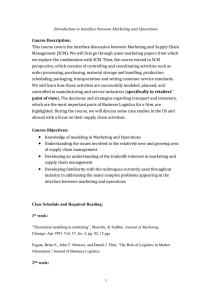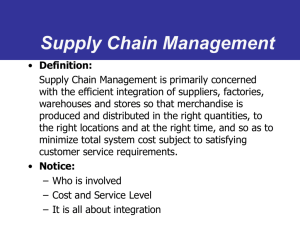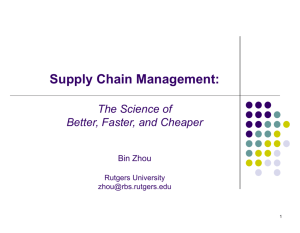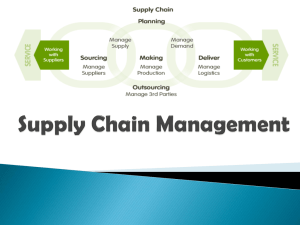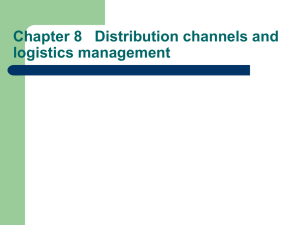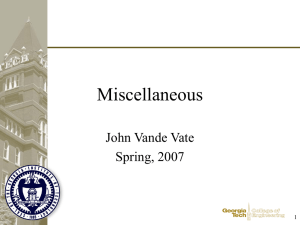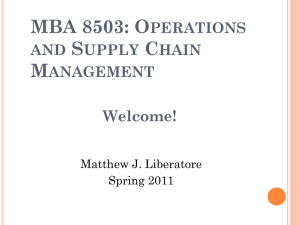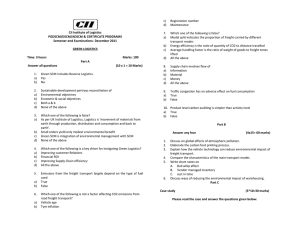CHAPTER 1 INTRODUCTION TO SUPPLY CHAIN MANAGEMENT
advertisement
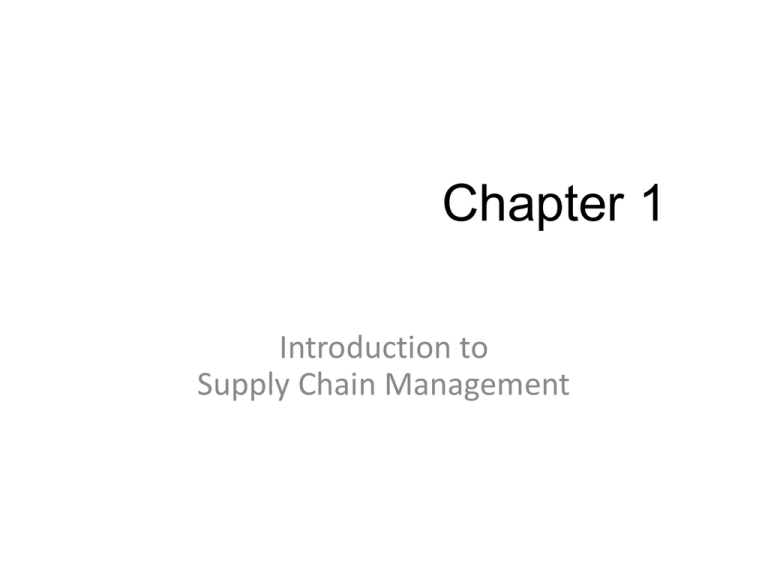
Chapter 1 Introduction to Supply Chain Management What Is a Supply Chain? Flow of products and services from: – – – – – Raw materials manufacturers Intermediate products manufacturers End product manufacturers Wholesalers and distributors and Retailers • Connected by transportation and storage activities • Integrated through information, planning, and integration activities • Cost and service levels 2 Cisco’s Value Network 3 The SCM Network FIGURE 1.1: The logistics network 4 Key Observations • Every facility that impacts costs need to be considered – Suppliers’ suppliers – Customers’ customers • Efficiency and cost-effectiveness throughout the system is required – System level approach • Multiple levels of activities – Strategic – Tactical – Operational 5 Other Related Observations • Supply chain strategy linked to the Development Chain • Challenging to minimize system costs and maximize system service levels • Inherent presence of uncertainty and risk 6 1.2 The Development Chain • Set of activities and processes associated with new product introduction. Includes: – product design phase – associated capabilities and knowledge – sourcing decisions – production plans 7 1.2 The Development Chain FIGURE 1-2: The enterprise development and supply chain 8 1.3 Global Optimization • Geographically dispersed complex network • Conflicting objectives of different facilities • Dynamic system – Variations over time – Matching demand-supply difficult – Different levels of inventory and backorders • Recent developments have increased risks – Lean production/Off-shoring/Outsourcing 9 Global Apparel Value Chain Tracing back the dress you are wearing 10 1.4 Uncertainty and Risk Factors Matching Supply and Demand a Major Challenge REASONS EXAMPLES •Raw material shortages •Internal and supplier parts Boeing Aircraft’s inventory writedown of $2.6 billion shortages •Productivity inefficiencies •Sales and earnings shortfall •Larger than anticipated inventories •Stiff competition •General slowdown in the PC Sales at U.S. Surgical Corporation declined 25 percent, resulting in a loss of $22 million Intel reported a 38 percent decline in quarterly profit market •Higher than expected orders for new products over existing products EMC Corp. missed its revenue guidance of $2.66 billion for the second quarter of 2006 by around $100 million 1.4 Uncertainty and Risk Factors Fluctuations of Inventory and Backorders throughout the Supply Chain FIGURE 1-3: Order variations in the supply chain 12 1.4 Uncertainty and Risk Factors • Forecasting is not a solution • Demand is not the only source of uncertainty • Recent trends make things more uncertain – Lean manufacturing – Outsourcing – Off-shoring 13 1.5 Evolution of Supply Chain Management Further Refinement of SCM Capabilities SCM Formation/ Extensions JIT, TQM, BPR, Alliances Inventory Management/Cost Optimization Traditional Mass Manufacturing 1950s 1960s 1970s 1980s 1990s 2000s Beyond 14 Progression of Logistics Costs FIGURE 1-4: Logistics costs’ share of the U.S. economy 15 Composition of Logistics Costs FIGURE 1-5: Total U.S. logistics costs between 1984 and 2005 16 1.6 Complexity: The Magnitude • U.S. companies spend more than $1 trillion in supplyrelated activities (10-15% of Gross Domestic Product) – Transportation 58% – Inventory 38% – Management 4% • The grocery industry could save $30 billion (10% of operating cost) by using effective logistics strategies • A typical box of cereal spends 104 days getting from factory to supermarket. • A typical new car spends 15 days traveling from the factory to the dealership. 17 Complexity: The Magnitude • Compaq computer’s loss of $500 million to $1 billion in sales in one year – Laptops and desktops were not available when and where customers were ready to buy them • Boeing’s forced announcement of write-downs of $2.6b – Raw material shortages, internal and supplier parts shortages…. • Cisco’s multi-billion ($2.2b) dollar write-off of inventories in 2001-2002 – Customers balked on orders due to market meltdown 18 Transactional Complexity National Semiconductors: • Production: – Produces chips in six different locations: four in the US, one in Britain and one in Israel – Chips are shipped to seven assembly locations in Southeast Asia. • Distribution – The final product is shipped to hundreds of facilities all over the world – 20,000 different routes – 12 different airlines are involved – 95% of the products are delivered within 45 days – 5% are delivered within 90 days. 19 PC Value Chain Performance of Traditional PC Manufacturer 20 PC Value Chain: Focus on Cost Reduction Performance of Dell Computers 21 Magnitude of Supply Chain Costs Cost Elements of a Typical Trade Book 22 Magnitude of Supply Chain Costs Example: The Apparel Industry Cost per Percent Shirt Saving Manufacturer Distributor Retailer Customer $52.72 0% Manufacturer Distributor Retailer Customer $41.34 28% Manufacturer Distributor Retailer Customer $20.45 62% 23
